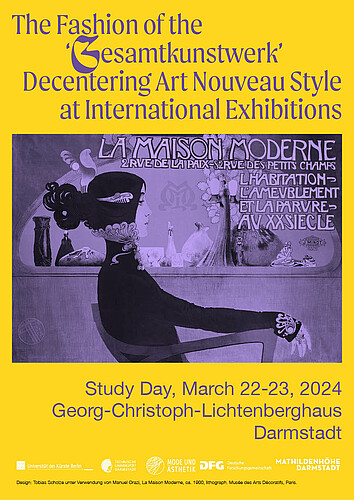The Fashion of the ‘Gesamtkunstwerk’: Decentering Art Nouveau Style at International Exhibitions
Study Day
March 22-23, 2024
Georg-Christoph-Lichtenberghaus (Darmstadt)
Study Day Program with Abstracts
„Maison Moderne“ – programmatically, the advertising poster by the artist Manuel Orazi, displayed at the Exposition Universelle in Paris in 1900, proclaims a ‘new style’: the ornamentally dressed young woman, enthroned on a curved chair in front of a display of vases and figurines, merges with the interior and becomes an allegory of modernity and consumption herself. By bringing together objects and artifacts from very different areas of handicrafts, the visual arts, technology and fashion at world expositions, the boundaries between these fields became porous. It is no coincidence that artistic concepts of breaking down the boundaries between art and life, culminating in the ‘Gesamtkunstwerk,’ were developed at the same time; indeed they featured prominently in the world’s fairs, along with Historicism and Art Nouveau. Design, fashion, and textiles played a central role in “Inventing the Modern World” (Busch/Futter) and stood, in fact, at the intersection of art and everyday life.
The principle of the ‘Gesamtkunstwerk’ was programmatic in multiple international exhibitions (Paris 1900, Turin 1902, St. Louis 1904), where the “Darmstadt Artists’ Colony Mathildenhöhe” was presented. Among the featured interior designs shown were also textile designs, such as those by Hans Christiansen for Joseph Maria Olbrich’s “Darmstadt Room,” which were celebrated as “Germany's Wonderful New Art” (Sunday Magazine 1904). The ‘Gesamtkunstwerk,’ the objective of which is actually to posit an unfragmented unity, stands here for modernity – a paradoxical undertaking, since modern society has become more and more differentiated since the eighteenth and nineteenth centuries. By the encounter of the arts and fashions of the various world regions, the expositions themselves became a catwalk for the ‘whole’ world.
In order to challenge such holistic models in the context of world’s fairs and the globalization processes they prompted the study day critically analyzes these expositions from a variety of fashion, design and art historical perspectives. By adopting post-colonial and gender approaches, questioning styles, canons, and artistic ‘progress,’ these entangled art and fashion histories provide the backdrop for a new and critical discussion of the terms of Art Nouveau, fashion, globalization, and ‘Gesamtkunstwerk’.
The study day therefore aims to ask and discuss: To what extent were the unifying conceptions of the ‘Gesamtkunstwerk’ connected with the presentations of fashion, textiles, and design at the world’s fairs? How do world’s fairs intersect and contribute to the emergence and distribution of new fashionable styles, such as Art Nouveau? How can constructions of modernity be critically reflected in the discourse of fashion and art within the global entanglements at world’s fairs?
The study day is organized by the DFG-funded research project “A Critical Art History of International and World Expositions Decentering Fashion and Modernities,” namely Alexandra Karentzos, Lizzy Rys, Miriam Oesterreich, and Elena Nustrini. It takes place March 22-23, 2024 in cooperation with and at the Institut Mathildenhöhe Darmstadt and at Technical University of Darmstadt.
For more information on the project, see: www.decentering-world-expositions.com
Program:
March 22, 2024
3.00 p.m.
Guided tour of the UNESCO World Heritage Mathildenhöhe Darmstadt
6.00 p.m.
Official Welcome
Dr. Philipp Gutbrod (Director of the Institut Mathildenhöhe)
Welcome and Opening of the Conference
Prof. Dr. Alexandra Karentzos (Technical University of Darmstadt)
Prof. Dr. Miriam Oesterreich (Berlin University of the Arts)
Elena Nustrini, M.A. (Berlin University of the Arts)
Lizzy Rys, M.A. (Technical University of Darmstadt)
6.30 p.m.
Keynote lecture
A Transnational Art Nouveau: The Fashionable Railway as Gesamtkunstwerk at the 1893 Chicago World’s Fair
Prof. Dr. Rebecca Houze (Northwestern Illinois University)
Moderation: Prof. Dr. Alexandra Karentzos
March 23, 2024
9.30 a.m.
Introduction
Prof. Dr. Alexandra Karentzos (Technical University of Darmstadt)
Prof. Dr. Miriam Oesterreich (Berlin University of the Arts)
Elena Nustrini, M.A. (Berlin University of the Arts)
Lizzy Rys, M.A. (Technical University of Darmstadt)
10.00 a.m.
Opening lecture
“Most Perfect Examples of Decorative Art” – Participations of the Darmstadt Artists’ Colony at the World’s Fairs
Dr. Sandra Bornemann-Quecke (Institut Mathildenhöhe)
Moderation: Prof. Dr. Miriam Oesterreich
10.45 a.m.
The Spectacle of Imperialism: Exhibiting the World at International Expositions
Dr. Catherine Futter (Brooklyn Museum)
Moderation: Prof. Dr. Miriam Oesterreich
11:30 a.m.
Coffee Break
11.45 a.m.
Fashion Behind Glass: Seduction, Alienation, and Experiences of the “Modern,” 1900-1908
Dr. Paula Alaszkiewicz (Avenir Museum of Design and Merchandising at Colorado State University)
Moderation: Lizzy Rys, M.A.
12.30 p.m.
Lunch Break
2.00 p.m.
Selling Art Nouveau fashion, 1890-1914
Dr. Clare Rose (Independent scholar and curator)
Moderation: Lizzy Rys, M.A.
2.45 p.m.
Fashion at the 1900 Exposition Universelle: Multiple Regimes of Display
Prof. Dr. Maude Bass-Krueger (Ghent University)
Moderation: Elena Nustrini, M.A.
3.30 p.m.
Coffee break
4.00 p.m.
Curating Hierarchies: the case of Hélène De Rudder embroideries and Bakuba textiles at the 1897 Brussels World’s Fair
Lizzy Rys, M.A. (Technical University of Darmstadt)
Moderation: Elena Nustrini, M.A.
4.45 p.m.
Final discussion
Moderation: Prof. Dr. Alexandra Karentzos, Prof. Dr. Miriam Oesterreich, Elena Nustrini, M.A., Lizzy Rys, M.A.
5.30 p.m.
End of Study Day
